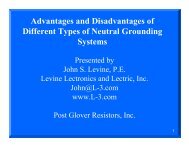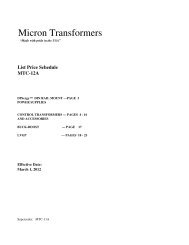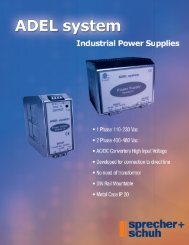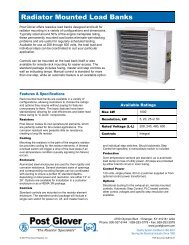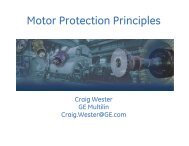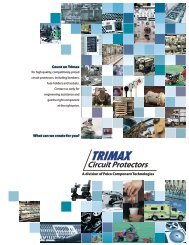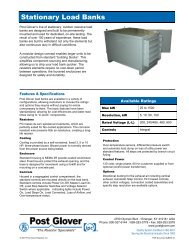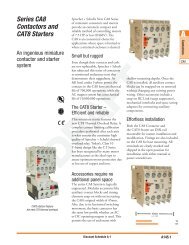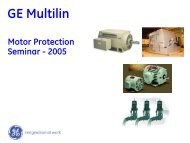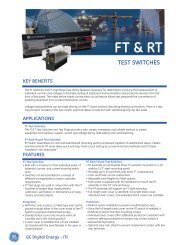IEEE Hybrid Grounding
IEEE Hybrid Grounding
IEEE Hybrid Grounding
Create successful ePaper yourself
Turn your PDF publications into a flip-book with our unique Google optimized e-Paper software.
c) If it can be assured that the generator will never be<br />
operated alone without being synchronized to the external<br />
power source, then a good solution would be to employ highresistance<br />
grounding of the generator and low-resistance<br />
grounding of the external source. For ground faults internal<br />
to the generator, the low-resistance grounding of the external<br />
source allows quick tripping of the generator breaker to<br />
isolate the fault, leaving the generator high-resistance<br />
grounded, thereby eliminating damages.<br />
d) Another option would be high-resistance grounding of<br />
both the generator and the external sources with the bus<br />
being low-resistance grounded via a grounding transformer<br />
supplied through a breaker. This grounding method would<br />
allow the system to continue to operate with the uncleared<br />
high-resistance ground fault present if the condition is<br />
alarmed and the fault is located and cleared in a timely<br />
manner. However, if adequate high-resistance grounding<br />
cannot be achieved, then it would be necessary to trip both<br />
the generator and external source when there is an uncleared<br />
downstream fault. Careful consideration must be given to all<br />
potential normal and contingency operating scenarios to<br />
permit plant operations to continue in the event of some<br />
unexpected component failures.<br />
It is important that any solution must be carefully<br />
engineered with particular attention in selecting equipment<br />
components that are suitably rated for the application.<br />
Practical solutions on new systems are relatively<br />
straightforward and involve application of the above<br />
mentioned two factors. On existing systems the problem of<br />
minimizing fault damage is more challenging. Furthermore,<br />
there is no one set of steps that will suffice for all existing<br />
systems. Therefore, it is necessary to consider carefully the<br />
architecture of each system to arrive at what will almost<br />
certainly be a compromise between the objective of<br />
minimizing potential fault damage and certain other<br />
operating objectives.<br />
A serious problem with existing systems is that their<br />
architecture is often complicated by the manner in which<br />
they have evolved over many years. It is also often the case<br />
that there is a perception that this complexity equates with<br />
reliability because it affords many different contingency<br />
operating modes. This in turn can lead to a situation where<br />
there is a desire to meet the grounding criteria mentioned<br />
above for all possible operating arrangements.<br />
Therefore, the first step in identifying a solution for existing<br />
systems is to identify what are the expected realistic<br />
operating modes of the system. That is, while it is certain that<br />
the system is expected to operate normally with everything<br />
intact, it is important to understand what kinds of outage<br />
contingencies must be allowed for.<br />
A reality is that it may be impossible to achieve risk<br />
mitigation for all practical operating conditions of complex<br />
systems. In this instance, it will be necessary to choose<br />
between accepting the risk of machine damage and limiting<br />
the number of operating contingencies that can be<br />
accommodated on the system.<br />
II. BIBLIOGRAPHY<br />
A. Industry Standards Publications<br />
1. <strong>IEEE</strong> Guide for Generator Ground Protection, <strong>IEEE</strong><br />
Standard C37.101, 1993.<br />
2. <strong>IEEE</strong> Guide for AC Generator Protection, <strong>IEEE</strong><br />
Standard C37.102, 1995.<br />
3. <strong>IEEE</strong> Guide for the Application of Neutral <strong>Grounding</strong> in<br />
Electrical Utility Systems, Part I – Introduction <strong>IEEE</strong><br />
Standard C62.92.2, 1989.<br />
4. <strong>IEEE</strong> Guide for the Application of Neutral <strong>Grounding</strong> in<br />
Electrical Utility Systems, Part II – <strong>Grounding</strong> of<br />
Synchronous Generator Systems, <strong>IEEE</strong> Standard<br />
C62.92.2, 1989.<br />
5. <strong>IEEE</strong> Recommended Practice for <strong>Grounding</strong> of<br />
Industrial and Commercial Power Systems (The Green<br />
Book), <strong>IEEE</strong> Standard 142, 1991.<br />
6. <strong>IEEE</strong> Recommended Practice for Protection and<br />
Coordination of Industrial and Commercial Power<br />
Systems (The Buff Book), <strong>IEEE</strong> Standard 242, 2001.<br />
7. <strong>IEEE</strong> Recommended Practice for Electric Power<br />
Distribution for Industrial Plants (The Red Book), <strong>IEEE</strong><br />
Standard 141, 1993 (Reaff 1999).<br />
8. <strong>IEEE</strong> Standard Requirements, Terminology and Test<br />
Procedures for Neutral <strong>Grounding</strong> Devices, <strong>IEEE</strong><br />
Standard 32, 1972 (Reaff 1997).<br />
9. American National Standard General Requirements for<br />
Synchronous Generators, ANSI C50.10, 1990.<br />
10. ANSI Requirements for Salient Pole Synchronous<br />
Generators and Generator/Motors for Hydraulic<br />
Turbine Applications, ANSI Standard C50.12, 1982.<br />
11. ANSI Standard for Rotating Electrical Generators –<br />
Cylindrical-Rotor Synchronous Generators, ANSI<br />
Standard C50.13, 1989.<br />
12. ANSI Requirements for Combustion Gas Turbine Driven<br />
Cylindrical Rotor Synchronous Generators, ANSI<br />
Standard C50.14, 1977.<br />
13. NEMA Standard for Motors and Generators, NEMA<br />
Standard MG1-1998 (Rev. 1, 2000).<br />
14. National Electrical Code, NFPA Standard 70, 1999.<br />
Article 250, <strong>Grounding</strong>.<br />
15. AIEE Standard No. 32, May 1947, p. 20, Table 32.2.21.<br />
B. Books and Technical Reports<br />
1. D. Beeman, Editor, Industrial Power Systems<br />
Handbook. New York: McGraw-Hill, 1955.<br />
78



